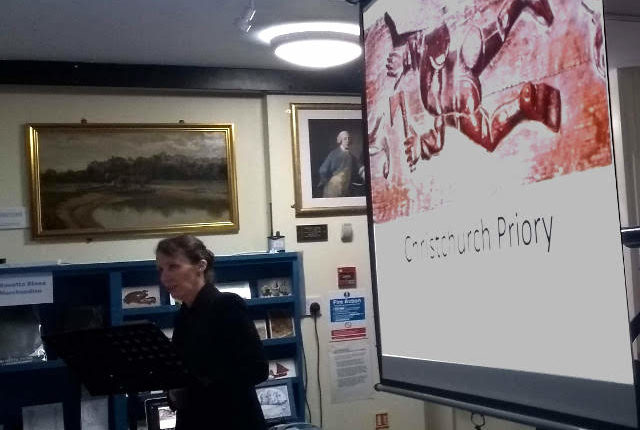A fascinating talk about the men who built Europe’s great medieval cathedrals was given at East Street Museum by author Imogen Corrigan, who has just written a book on the subject.
Imogen is known to be an outstanding speaker which meant there were no vacant seats at the museum on Thursday evening, February 14 – and the hour of fascinating information imparted with excitement and humour (and accompanied by stunning photos taken at scores of cathedrals throughout Europe) not only fulfilled the high expectations of the audience but – to judge by post-talk questions and enthusiastic comments – exceeded them.
Many who attended confessed to having stood in a cathedral and wondered how such a magnificent building could have been produced during the medieval period, given the materials, tools, construction techniques and the means of communication, financing, record-keeping and workforce control of the times.
Photos of paintings, carvings and models presented sights such as a man perched on a razor-thin point dizzily high in the sky with no visible means of support, and sites with scaffolding, human-powered treadmills attached to cranes, wheelbarrows and workers busy with stone carving, carpentry, tiling and a wide range of other special tasks.
Certainly the presentation gave us a new appreciation of the realities of medieval times. For example, the initiators of a building did not expect to see the final result which for varied reasons – such as improved materials and techniques, changes in fashion and finances and who was in control – was invariably quite different from how the original master mason (we would call him an architect perhaps) would have imagined.
Cathedrals evolved. Many were works in progress for centuries. The projects involved workers in many different trades, speaking many different languages, demonstrating ingenuity as well as skills, often moving from one project to another.
Many of the questions today’s cathedral visitors wonder about were tackled. Some much-abbreviated examples: Who was a master mason? Someone who had proved they had real skills – deserving to be called a ‘master’ and a character commanding respect. Who was in charge? Typically a master mason working to a brief often coming from a bishop, who might also be the chief source of finance. What about pay for the workers? Skilled workers were often paid quite well. Why were the cathedrals built? Partly to attract money, partly for the glory of God. What is the significance of the marks often found on stones? Not what many think; rather they simply indicated who was to be paid for carving the stone.
There is much more to the master masons than the quick examples above and the fuller story is now available in print: Stone on Stone: The Men Who Built The Cathedrals by Imogen Corrigan is published by Robert Hale (start your Amazon search at www.ryemuseum.co.uk and a portion of the purchase price goes to the museum).
And you can now make a note in your diary of the second museum talk of 2019 by another favourite speaker. Come to the East Street Museum on Thursday, March 14 to hear Dr Andrew Bamji on The Wrong Sex: A strange story of surgical success and unrequited love.
Image Credits: Rye Museum .



